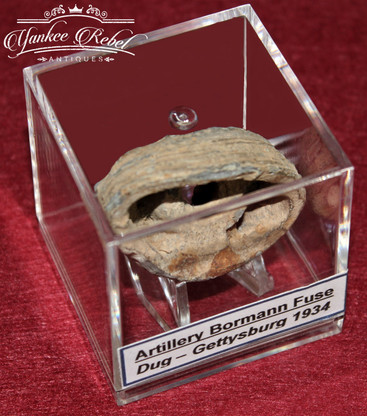 Loading... Please wait...
Loading... Please wait...-
Call us on (973) 810-2976
- My Account
- Gift Certificates
- Items / $0.00
All prices are in All prices are in USD
Categories
- Home
- Artillery related items
- Artillery Bormann fuse recovered by a CCC worker at Gettysburg between 1934 – 1936
- Home
- Gettysburg Related Items
- Artillery Bormann fuse recovered by a CCC worker at Gettysburg between 1934 – 1936
- Home
- Identified Artifacts
- Artillery Bormann fuse recovered by a CCC worker at Gettysburg between 1934 – 1936
- Home
- Excavated Artifacts
- Artillery Bormann fuse recovered by a CCC worker at Gettysburg between 1934 – 1936
- Home
- Personal Items
- Artillery Bormann fuse recovered by a CCC worker at Gettysburg between 1934 – 1936
- Home
- Gettysburg Souvenirs
- Artillery Bormann fuse recovered by a CCC worker at Gettysburg between 1934 – 1936
Artillery Bormann fuse recovered by a CCC worker at Gettysburg between 1934 – 1936
Product Description
This is another nice piece being offered, it is an excavated Confederate Bormann time fuse. It is named after its inventor, Belgian Army Captain Charles G. Bormann. The time fuse is contained in a tin and lead disk (see pictures). It was recovered by a laborer in the Civilian Conservation Corps (CCC) at the Gettysburg Battlefield during 1934 – 1936 (see pictures).
The disk has time markings indicated in seconds and quarter-seconds graduated up to 5 1/4 seconds. The artillerist used a metal punch to pierce the thin metal at the desired time marking. This exposed a section in the horseshoe-shaped horizontal mealed powder train, which is covered by a thin sheet of tin. When the cannon discharged, the flame from the explosion ignited this powder train. In my book “Civil War Artillery – A Pictorial Introduction”, I discuss these shells and fuses in more detail (see pictures).
In the summer of 1934, some seventy years after generals Robert E. Lee and George G. Meade led their armies to Gettysburg, a new army arrived. Composed of young men, this new volunteer army was unlike any one created by the United States government before. Instead of shouldering rifles, these volunteers were armed with shovels, saws, and pickaxes.
Rather than learn about military strategy and tactics, these men were taught about the conservation of the nation’s natural resources. Their enemy was not some foreign power. The enemy was an economic depression that had, at its height, put an estimated fifteen million Americans out of work and denied them the opportunity to support their communities, families, and themselves. This new army was called the Civilian Conservation Corps (CCC), and Gettysburg was but one battlefield in the campaign to put Americans back to work.
This piece, along with several others, were obtained directly from a Pennsylvania family. The grandfather was in the CCC at Gettysburg and brought some battlefield relics home with him. Back then there was such an abundance of Civil War relics, and most had little value, so there was no problem keeping what you found. It comes in the acrylic display case pictured.



